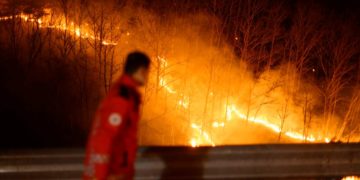CHEONGSONG, South Korea — Helicopters dumped water over a burning forest in South Korea on Thursday as authorities struggled to contain the country’s worst-ever wildfires, which have killed 26 people, forced at least 37,000 others to flee their homes and destroyed more than 300 structures.
Multiple wildfires have been raging across South Korea’s southeastern regions since last Friday. The government has mobilized thousands of people, dozens of helicopters and other equipment to extinguish the blazes, but officials said strong winds are hampering their efforts.
Korea Forest Service chief Lim Sang-seop said “a small amount” — less than 0.2 inches — of rain was expected in the area on Thursday, not enough to play a meaningful role in extinguishing the wildfires.
The fatalities include a pilot whose helicopter crashed during efforts to contain a fire and four firefighters and other workers who died after being trapped by fast-moving flames driven by strong winds.
Authorities have not disclosed details of the civilian dead, except that they are mostly in their 60s and 70s. They suspect human error caused several of the wildfires, including cases where people started fires while clearing overgrown grass from family tombs or with sparks during welding work.
The wildfires have burned 88,980 acres of land in the southeast, the government’s disaster response center said in a report Thursday. Observers say that is the worst figure of its kind in South Korea. The report said the blazes have also injured 30 people, eight of them seriously, destroyed 325 buildings and structures and forced more than 37,180 people to evacuate.
As of Thursday morning, the center said authorities were mobilizing more than 9,000 people and about 120 helicopters to battle the wildfires.
In Cheongsong, one of the fire-hit areas, thick plumes of smoke were billowing from Juwang Mountain. Helicopters repeatedly hovered over the mountain, dropping water. The amount of smoke later appeared to have diminished.
At a Buddhist temple near the mountain, workers covered a stone pagoda and other structures with fire-resistant materials, while firefighters poured water on sites near the temple.
“Damages are snowballing,” acting President Han Duck-soo said in a televised address on Wednesday. “There are concerns that we’ll have wildfire damages that we’ve never experienced, so we have to concentrate all our capabilities on putting out the wildfires this week.”
The hardest-hit areas include Andong city and the neighboring counties of Uiseong and Sancheong, and the city of Ulsan.
On Wednesday night, strong winds and smoke-filled skies forced authorities in the southeastern city of Andong to order evacuations in two villages, including Puncheon, home to the Hahoe folk village — a UNESCO World Heritage Site founded around the 14th-15th century. Hikers were advised to leave the scenic Jiri Mountain as another fire spread closer.
Officials said earlier this week that firefighters had extinguished most of the flames from the largest wildfires in key areas, but wind and dry conditions allowed them to spread again.
Destroyed in the blazes were houses, factories, vehicles and some historic structures. In Uiseong, about 20 of the 30 structures at the Gounsa temple complex, which was said to be originally built in the 7th century, have been burned. Among them were two state-designated “treasures” — a pavilion-shaped building erected overlooking a stream in 1668, and a Joseon dynasty structure built in 1904 to mark the longevity of a king.
The Korea Forest Service has raised its wildfire warning to the highest level, requiring local governments to assign more workers to emergency response, tighten entry restrictions for forests and parks, and recommend that military units withhold live-fire exercises.
The post South Korea is in an uphill battle to contain massive wildfires as the death toll rises to 26 appeared first on NBC News.



















